2.4: The Neolithic Period
- Page ID
- 52984
\( \newcommand{\vecs}[1]{\overset { \scriptstyle \rightharpoonup} {\mathbf{#1}} } \)
\( \newcommand{\vecd}[1]{\overset{-\!-\!\rightharpoonup}{\vphantom{a}\smash {#1}}} \)
\( \newcommand{\dsum}{\displaystyle\sum\limits} \)
\( \newcommand{\dint}{\displaystyle\int\limits} \)
\( \newcommand{\dlim}{\displaystyle\lim\limits} \)
\( \newcommand{\id}{\mathrm{id}}\) \( \newcommand{\Span}{\mathrm{span}}\)
( \newcommand{\kernel}{\mathrm{null}\,}\) \( \newcommand{\range}{\mathrm{range}\,}\)
\( \newcommand{\RealPart}{\mathrm{Re}}\) \( \newcommand{\ImaginaryPart}{\mathrm{Im}}\)
\( \newcommand{\Argument}{\mathrm{Arg}}\) \( \newcommand{\norm}[1]{\| #1 \|}\)
\( \newcommand{\inner}[2]{\langle #1, #2 \rangle}\)
\( \newcommand{\Span}{\mathrm{span}}\)
\( \newcommand{\id}{\mathrm{id}}\)
\( \newcommand{\Span}{\mathrm{span}}\)
\( \newcommand{\kernel}{\mathrm{null}\,}\)
\( \newcommand{\range}{\mathrm{range}\,}\)
\( \newcommand{\RealPart}{\mathrm{Re}}\)
\( \newcommand{\ImaginaryPart}{\mathrm{Im}}\)
\( \newcommand{\Argument}{\mathrm{Arg}}\)
\( \newcommand{\norm}[1]{\| #1 \|}\)
\( \newcommand{\inner}[2]{\langle #1, #2 \rangle}\)
\( \newcommand{\Span}{\mathrm{span}}\) \( \newcommand{\AA}{\unicode[.8,0]{x212B}}\)
\( \newcommand{\vectorA}[1]{\vec{#1}} % arrow\)
\( \newcommand{\vectorAt}[1]{\vec{\text{#1}}} % arrow\)
\( \newcommand{\vectorB}[1]{\overset { \scriptstyle \rightharpoonup} {\mathbf{#1}} } \)
\( \newcommand{\vectorC}[1]{\textbf{#1}} \)
\( \newcommand{\vectorD}[1]{\overrightarrow{#1}} \)
\( \newcommand{\vectorDt}[1]{\overrightarrow{\text{#1}}} \)
\( \newcommand{\vectE}[1]{\overset{-\!-\!\rightharpoonup}{\vphantom{a}\smash{\mathbf {#1}}}} \)
\( \newcommand{\vecs}[1]{\overset { \scriptstyle \rightharpoonup} {\mathbf{#1}} } \)
\( \newcommand{\vecd}[1]{\overset{-\!-\!\rightharpoonup}{\vphantom{a}\smash {#1}}} \)
\(\newcommand{\avec}{\mathbf a}\) \(\newcommand{\bvec}{\mathbf b}\) \(\newcommand{\cvec}{\mathbf c}\) \(\newcommand{\dvec}{\mathbf d}\) \(\newcommand{\dtil}{\widetilde{\mathbf d}}\) \(\newcommand{\evec}{\mathbf e}\) \(\newcommand{\fvec}{\mathbf f}\) \(\newcommand{\nvec}{\mathbf n}\) \(\newcommand{\pvec}{\mathbf p}\) \(\newcommand{\qvec}{\mathbf q}\) \(\newcommand{\svec}{\mathbf s}\) \(\newcommand{\tvec}{\mathbf t}\) \(\newcommand{\uvec}{\mathbf u}\) \(\newcommand{\vvec}{\mathbf v}\) \(\newcommand{\wvec}{\mathbf w}\) \(\newcommand{\xvec}{\mathbf x}\) \(\newcommand{\yvec}{\mathbf y}\) \(\newcommand{\zvec}{\mathbf z}\) \(\newcommand{\rvec}{\mathbf r}\) \(\newcommand{\mvec}{\mathbf m}\) \(\newcommand{\zerovec}{\mathbf 0}\) \(\newcommand{\onevec}{\mathbf 1}\) \(\newcommand{\real}{\mathbb R}\) \(\newcommand{\twovec}[2]{\left[\begin{array}{r}#1 \\ #2 \end{array}\right]}\) \(\newcommand{\ctwovec}[2]{\left[\begin{array}{c}#1 \\ #2 \end{array}\right]}\) \(\newcommand{\threevec}[3]{\left[\begin{array}{r}#1 \\ #2 \\ #3 \end{array}\right]}\) \(\newcommand{\cthreevec}[3]{\left[\begin{array}{c}#1 \\ #2 \\ #3 \end{array}\right]}\) \(\newcommand{\fourvec}[4]{\left[\begin{array}{r}#1 \\ #2 \\ #3 \\ #4 \end{array}\right]}\) \(\newcommand{\cfourvec}[4]{\left[\begin{array}{c}#1 \\ #2 \\ #3 \\ #4 \end{array}\right]}\) \(\newcommand{\fivevec}[5]{\left[\begin{array}{r}#1 \\ #2 \\ #3 \\ #4 \\ #5 \\ \end{array}\right]}\) \(\newcommand{\cfivevec}[5]{\left[\begin{array}{c}#1 \\ #2 \\ #3 \\ #4 \\ #5 \\ \end{array}\right]}\) \(\newcommand{\mattwo}[4]{\left[\begin{array}{rr}#1 \amp #2 \\ #3 \amp #4 \\ \end{array}\right]}\) \(\newcommand{\laspan}[1]{\text{Span}\{#1\}}\) \(\newcommand{\bcal}{\cal B}\) \(\newcommand{\ccal}{\cal C}\) \(\newcommand{\scal}{\cal S}\) \(\newcommand{\wcal}{\cal W}\) \(\newcommand{\ecal}{\cal E}\) \(\newcommand{\coords}[2]{\left\{#1\right\}_{#2}}\) \(\newcommand{\gray}[1]{\color{gray}{#1}}\) \(\newcommand{\lgray}[1]{\color{lightgray}{#1}}\) \(\newcommand{\rank}{\operatorname{rank}}\) \(\newcommand{\row}{\text{Row}}\) \(\newcommand{\col}{\text{Col}}\) \(\renewcommand{\row}{\text{Row}}\) \(\newcommand{\nul}{\text{Nul}}\) \(\newcommand{\var}{\text{Var}}\) \(\newcommand{\corr}{\text{corr}}\) \(\newcommand{\len}[1]{\left|#1\right|}\) \(\newcommand{\bbar}{\overline{\bvec}}\) \(\newcommand{\bhat}{\widehat{\bvec}}\) \(\newcommand{\bperp}{\bvec^\perp}\) \(\newcommand{\xhat}{\widehat{\xvec}}\) \(\newcommand{\vhat}{\widehat{\vvec}}\) \(\newcommand{\uhat}{\widehat{\uvec}}\) \(\newcommand{\what}{\widehat{\wvec}}\) \(\newcommand{\Sighat}{\widehat{\Sigma}}\) \(\newcommand{\lt}{<}\) \(\newcommand{\gt}{>}\) \(\newcommand{\amp}{&}\) \(\definecolor{fillinmathshade}{gray}{0.9}\)Neolithic Art
Art in the Neolithic Near East owes its existence to developments in agriculture, architecture, and other areas.
Outline the phases of the Neolithic period in the Near East and identify characteristics of each
Key Points
- The Neolithic is signified by a progression in behavioral and cultural characteristics including the cultivation of wild and domestic crops and the use of domesticated animals.
- Neolithic culture in the Near East is separated into three phases based on agricultural developments, advances in architecture, and the production of pottery.
- The temple located in southeastern Turkey at Gobekli Tepe circa 10,000 BCE is the oldest human-made place of worship. Among the architectural finds are pillars decorated with reliefs of animals.
- The settlement at ‘Ain Ghazal in present-day Jordan is best known as the earliest culture to produce large-scale human figures. Lacking details beyond the face and intended to be viewed only from the front, these likely served funerary purposes.
- Terra cotta pottery and fertility figures were found at Tell-Halaf in northern Syria and Tell-al-Ubaid on the coast of the Persian Gulf.
Key Terms
- domesticated:Tame, naturalized.
The Neolithic or New Stone Age was a period in human development from around 10,000 BCE until 3,000 BCE. Considered the last part of the Stone Age, the Neolithic period is signified by a progression in behavioral and cultural characteristics including the cultivation of wild and domestic crops and the use of domesticated animals.
The ancient Near East was home to the earliest civilizations within a region roughly corresponding to the modern Middle East, including Mesopotamia , ancient Egypt, ancient Iran, the Levant, and the Arabian peninsula. Sites in these locations dating to approximately 9500 BCE are considered the beginning of the Neolithic period.
Neolithic culture in the Near East is separated into three phases: Neolithic 1 (Pre-Pottery Neolithic A), Neolithic 2 (Pre-Pottery Neolithic B), and Neolithic 3 (Pottery Neolithic).
Neolithic 1 (PPNA)
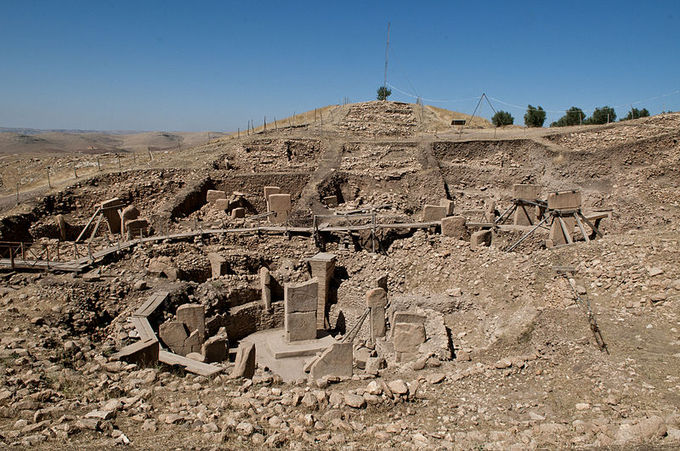
The Neolithic 1 phase likely began with a temple in southeastern Turkey at Gobekli Tepe circa 10,000 BCE. The structure is as the oldest known human-made place of worship. It features seven stone circles covering 25 acres that contain limestone pillars carved with animals, insects, and birds, believed to serve as roof supports. The complexity of the temple and the effort involved in its construction imply it was built by long-term settlers. The major advances of the Neolithic 1 phase revolve around developments in farming practices, such as harvesting, seed selection, and the domestication of plants and animals.
At the oldest layer of Gobekli Tepe, T-shaped mud brick pillars are decorated with abstract , enigmatic pictograms and carved animal reliefs. The pictograms may represent commonly understood sacred symbols known from Neolithic cave paintings elsewhere. The reliefs depict mammals such as lions, bulls, boars, foxes, gazelles, and donkeys; snakes and other reptiles; arthropods, such as insects and arachnids; and birds, particularly vultures. The deceased were likely exposed for consumption by vultures and other carrion birds.
When the edifice was constructed, the surrounding country was likely forested and capable of sustaining this variety of wildlife, before millennia of settlement and cultivation led to the near-Dust Bowl conditions prevalent today.
Neolithic 2 (PPNB)
The Neolithic 2 began around 8800 BCE and is characterized by settlements built with rectangular mud-brick houses with single or multiple rooms, the greater use of domesticated animals, and advancements in tools. These developments in architecture point to settlement in permanent locations. While mud brick is perishable, the investment of time and effort in the construction of houses indicates the desire to remain in a single location for the long term. Burial findings and the preservation of skulls of the dead, often plastered with mud to create facial features, suggest an ancestor cult.
A settlement of 3,000 inhabitants was found in the outskirts of Amman, Jordan. Considered to be one of the largest prehistoric settlements in the Near East, ‘Ain Ghazal was continuously inhabited from approximately 7,250 – 5,000 BCE. This settlement produced what are believed to be the earliest large-scale human figures. Modeled from plaster, these consist of full statues and busts, some of which are two-headed. Great effort was put into modeling the heads, with wide-open eyes and bitumen-outlined irises. The statues represent men, women, and children. Women are recognizable by features resembling breasts and slightly enlarged bellies, but neither male nor female sexual characteristics are emphasized, and none of the statues have genitals. Only the faces have detail.
Although they were produced to be free-standing, they were likely intended to be viewed only from the front, hence their disproportionate flatness. The manufacture of the statues would not have permitted them to last long. Since they were buried in pristine condition, they may have been produced for the purpose of intentional burial and never been displayed.
Neolithic 3 (PN)
Beginning around 6400 BCE, this period is characterized by the emergence of distinctive cultures throughout the Fertile Crescent , such as the Halafian (Turkey, Syria, Northern Mesopotamia) and Ubaid (Southern Mesopotamia).
Pottery was first produced and used in this era, a direct effect of agriculture and the permanent settlements that arose as a result. No longer nomadic , individuals used ceramic vessels to store the food they grew or raised and water collected from local sources. Additionally, the need arose for plates, cups, and additional objects used in the consumption of food and beverages.
Halafian Period
Tell Halaf is an archaeological site in northeastern Syria near the Turkish border, that flourished from about 6100 to 5400 BCE. It was the first site of Neolithic culture, subsequently dubbed Halafian culture, characterized by glazed pottery painted with geometric and animal designs.
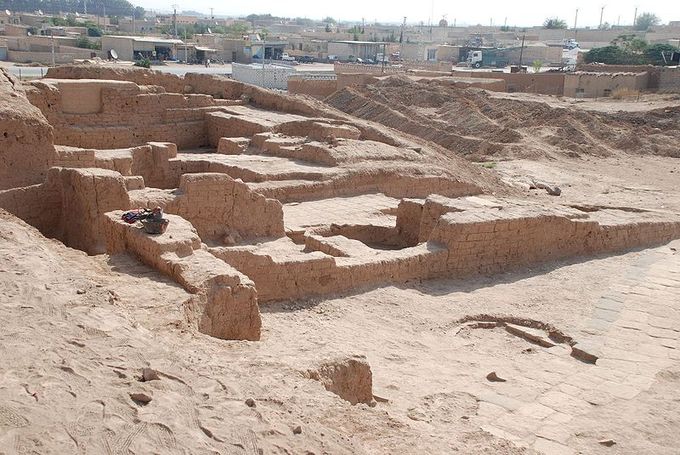
The best known, most characteristic pottery of Tell Halaf, called Halaf ware, was produced by specialist potters. It was sometimes painted with one or two colors (the latter called polychrome) with geometric and animal motifs . Other types of Halaf pottery include unpainted cookware and ware with burnished surfaces.
There are many theories about the development of this distinctive pottery style . The polychromatic painted Halaf pottery has been proposed to be a “trade pottery”—pottery produced for export—however, the predominance of locally produced painted pottery in all areas of Halaf sites calls that theory into question. That said, Halaf pottery has been found in other parts of northern Mesopotamia and at many sites in Anatolia (Turkey) suggesting that it was widely used in the region.
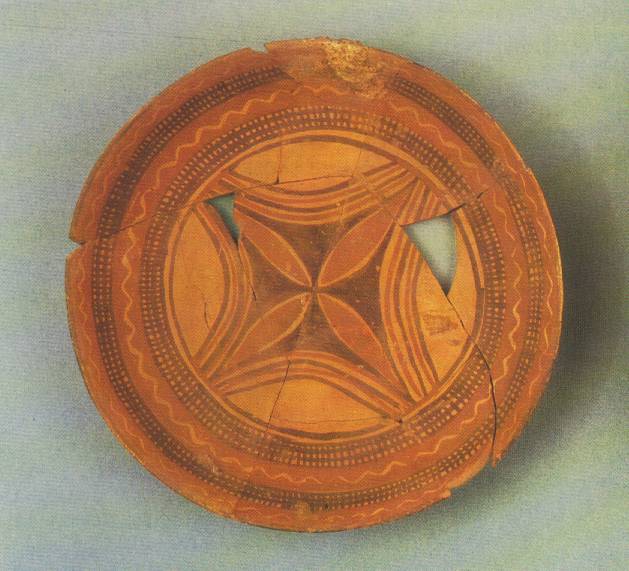
In addition to ceramics, the Halafian culture produced female figurines of partially baked clay and stone. Because of the prominence of their breasts and abdomens and subordination of their facial features, they are likely fertility figures. As the bands on the figure below suggest, these figurines were painted to some extent.
Ubaid Period
The Ubaid culture flourished from about 6500 to 3800 BCE in Mesopotamia and is characterized by large village settlements that employed multi-room rectangular mud-brick houses. The appearance of the first temples in Mesopotamia, as well as greenish pottery decorated with geometric designs in brown or black paint, are important developments of this period. Tell-al-Ubaid is a low, relatively small mound site that extends about two meters above ground level. The lower level was a site where large amounts of Ubaid pottery, kilns , and a cemetery were discovered.
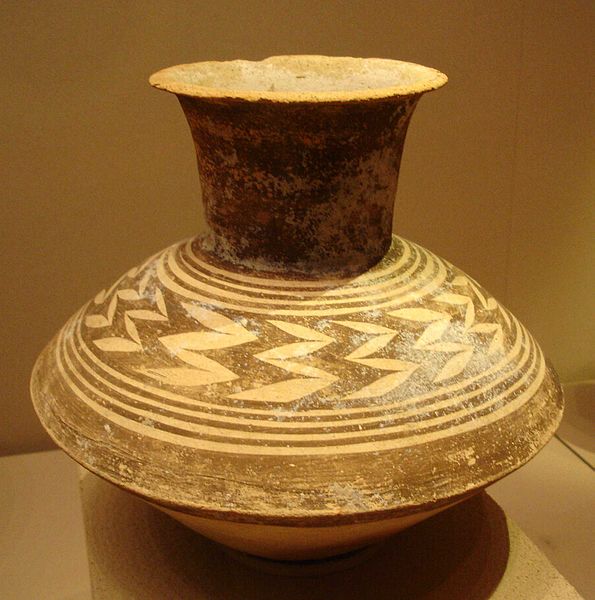
Neolithic Monuments
Neolithic art in Western Europe is best represented by its megalithic (large stone) monuments.
Describe Neolithic cultural characteristics in Western Europe, particularly passage tombs and megaliths particular.
Key Points
- The Neolithic or New Stone Age was a period in human development from around 10,000 BCE until 3,000 BCE.
- Stonehenge and Avebury, both located in the county of Wiltshire in England, are the best known megalithic henges . Both were built in stages over several centuries. Their exact purposes remain a matter of debate.
- Passage tombs or graves consist of narrow passages made of large stones and one or multiple burial chambers been covered in earth or stone. A common layout is the cruciform passage grave .
- The carvings at Newgrange and Knowth are separated into ten categories consisting of curvilinear and rectilinear forms . The monuments at both sites are aligned with the solstices and equinoxes.
- The megalithic temples in Ggantija, Malta, have been theorized as possible sites of a fertility cult due to numerous figurines found on site.
Key Terms
- rectilinear:In a straight line.
- henge:A prehistoric enclosure in the form of an arc, defined by a raised circular bank and a circular ditch inside the bank, with one or more entrances to the enclosed open space.
- trilithon:A structure consisting of two stone pillars supporting a horizontal stone.
- cruciform:Having the shape of a cross.
- serpentiform:Having the form of a serpent.
- curvilinear:Formed by curved lines.
- passage grave:A burial chamber consisting of a narrow passage made of large stones and one or multiple burial chambers covered in earth or stone.
Also known as the New Stone Age, the Neolithic period in human development lasted from around 10,000 BCE until 3,000 BCE. Considered the last part of the Stone Age, the Neolithic is signified by a progression in behavioral and cultural characteristics including the cultivation of wild and domestic crops and the use of domesticated animals.
Agrarian societies first appeared in southeast Europe in the seventh millennium BCE. Through migration and cultural diffusion, Neolithic traditions spread to northwestern Europe by around 4500 BCE. The development of agriculture allowed groups of people to form larger permanent settlements in single locations, as opposed to living as nomadic hunter gatherers. Permanent settlements resulted in the construction of megalithic monuments requiring considerable time and effort that was unavailable to nomads .
Megalithic Henges
Neolithic societies produced female and animal statues, engravings , and elaborate pottery decoration. In Western Europe, though, this period is best represented by the megalithic (large stone) monuments and passage tomb structures found from Malta to Portugal, through France and Germany, and across southern England to most of Wales and Ireland.
Stonehenge
Perhaps the best known megalithic henge is Stonehenge, located on Salisbury Plain in the county of Wiltshire in south central England. Archaeologists believe it was constructed from 3000 BCE to 2000 BCE. The surrounding circular earth bank and ditch, which constitute the earliest phase of the monument, have been dated to about 3100 BCE. Radiocarbon dating suggests that the first bluestones in the innermost ring of Stonehenge were raised between 2400 and 2200 BCE, although they may have been at the site as early as 3000 BCE.
Although human remains have been found at the site, archaeologists are uncertain whether the site served funerary purposes, ritual purposes, or both. Its alignments with the sunrise of the summer solstice and sunset of the winter solstice present the possibility that the site served as a rudimentary astronomical calendar to help early agrarian societies acclimate to the approaching growing season and harvest.
Even the smallest bluestones weigh several tons each. These stones, so-called because they appear blue when wet, were quarried approximately 150 miles away in the Prescelli Mountains in southwest Wales. Even more impressive, the quarrying and transport of the stones took place without the aid of the wheel, requiring a sophisticated method of transport and construction involving felled trees and earthen mounds. The larger Sarcen stones that form the post-and-lintel ring and he free-standing trilithons were quarried approximately 25 miles to the north of Salisbury Plain, requiring the same transport system of felled trees and earthen mounds.
Avebury
One of the best known prehistoric sites in the United Kingdom, Avebury contains the largest stone circle in Europe. Located in the same county as Stonehenge, Avebury lies north of the better-known site. Constructed over several hundred years in the third millennium BCE, the monument comprises a large henge with a large outer stone circle and two separate smaller stone circles situated inside the center of the monument. Its original purpose is unknown, although archaeologists believe that it was likely used for ritual or ceremony . The Avebury monument was part of a larger prehistoric landscape containing several older monuments.
The chronology of Avebury’s construction is unclear. It was not designed as a single monument but was the result of various projects undertaken at different times during late prehistory . Experts date the construction of the central cove to 3,000 BCE, the inner stone circle to 2,900 BCE, the outer circle and henge to 2,600 BCE, and the avenues to 2,400 BCE. The construction of Avebury and Stonehenge indicate that a stable agrarian economy had developed in this region of England by 4000 to 3500 BCE.
Passage Tombs
Passage tombs or graves consist of narrow passages made of large stones and one or multiple burial chambers covered in earth or stone. Megaliths were commonly used in the construction of passage tombs and typically date to the Neolithic. A common layout is the cruciform passage grave, characterized by a cross-shaped structure.
Newgrange, Ireland
Newgrange is part of the Neolithic Bru na Boinne complex, a collection of passage tomb mounds built around 3200 BCE and located in County Meath, Ireland.
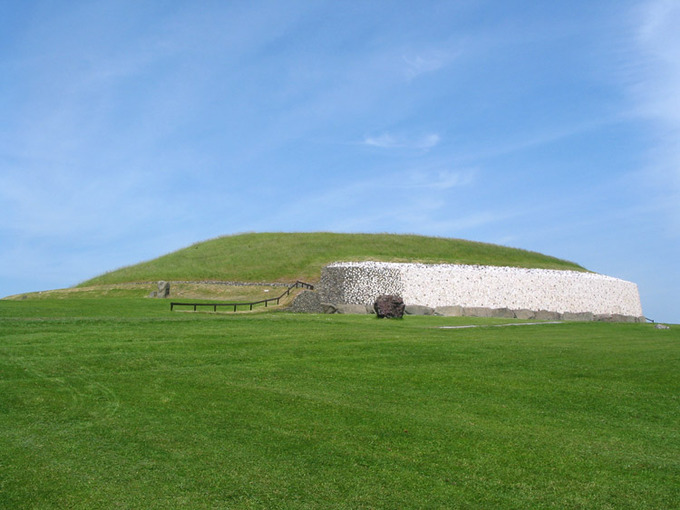
The Newgrange monument is comprised of a large mound built of alternating layers of earth and stones, covered with growing grass and with flat white quartz stones studded around the circumference. The mound covers 4500 square meters of ground . Within, a passage stretches through the structure ending at three small chambers.
Newgrange contains various examples of abstract Neolithic art carved onto its rocks. These are separated into 10 categories consisting of curvilinear forms like circles, spirals, arcs, serpentiforms, and dot-in-circles, as well as rectilinear examples such as chevrons, lozenges, radials, parallel lines , and offsets.
There is no agreement as to what the site was used for, but it has been speculated that it had some form of religious significance due to its alignment with the rising sun which floods the stone room with light on the winter solstice.
Knowth, Ireland
Knowth is a Neolithic passage grave and monument located in the valley of the River Boyne in Ireland. Located in close proximity to similar sites such as Newgrange, Knowth consists of one large cruciform passage tomb and 17 smaller satellite tombs, estimated to date between 2500 and 2000 BCE.
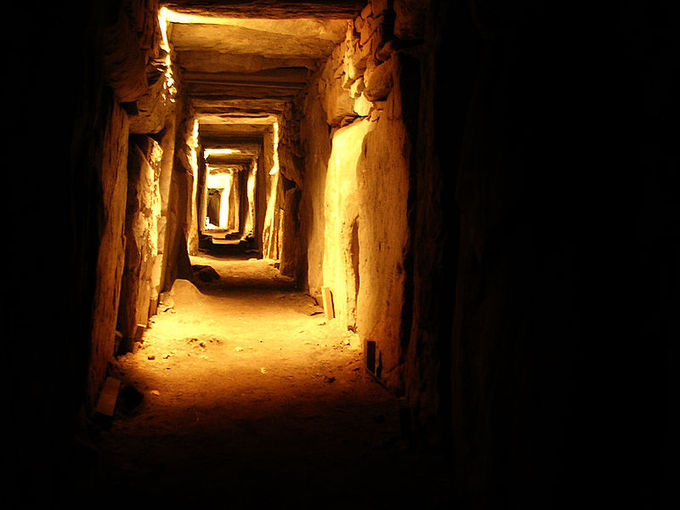
Additionally, the monument contains three recesses and basin stones into which the cremated remains of the dead were placed. The right recess is larger and more elaborately decorated than the others, a typical trait of Irish passage graves. The reason, however, remains unknown. Many monuments at Knowth were megalithic tombs, and archaeologists speculate that most have religious significance.
Knowth is reputed to have approximately one-third of all megalithic art in Western Europe carved into its rock faces. Typical motifs include spirals, lozenges, and serpentiform markings. Much of the art was carved on the backs of stones, a phenomenon known as hidden art. There are many theories about the function of hidden art, including a desire to hide images or the recycling of stones in order to use both sides.
Ggantija, Malta
The megalithic temple complexes of Ggantija on the Mediterranean islands of Gozo and Malta are notable for their gigantic Neolithic structures dating to 3,600 BCE.

Situated at the end of the Xanghra plateau and facing the southeast, the temples are built in a clover-leaf shape, with inner facing blocks marking the outline which was then filled with rubble. They lead to a series of semi-circular apses connected by a central passage.
The temples have been theorized as the possible site of a fertility cult due to numerous figurines found on site. The Hypogeum of Hal-Saflieni, located in Pola, Malta, is a subterranean structure excavated circa 2500 BCE, the only prehistoric underground temple in the world, showing a degree of stone artistry unique to the Maltese islands.
- Curation and Revision. Provided by: Boundless.com. License: CC BY-SA: Attribution-ShareAlike
- Gu00f6bekli Tepe, Urfa. Provided by: Wikipedia. Located at: en.Wikipedia.org/wiki/File:G%C3%B6bekli_Tepe,_Urfa.jpg. License: CC BY-SA: Attribution-ShareAlike
- 640px-20100923_amman41.jpeg. Provided by: Wikimedia Commons. Located at: commons.wikimedia.org/w/index.php?curid=11749560. License: CC BY-SA: Attribution-ShareAlike
- 319px-Gobekli_Tepe_2.jpg. Provided by: Wikimedia Commons. Located at: commons.wikimedia.org/w/index.php?curid=17377759. License: CC BY-SA: Attribution-ShareAlike
- Frieze-group-3-example1. Provided by: Wikipedia. Located at: en.Wikipedia.org/wiki/File:Frieze-group-3-example1.jpg. License: Public Domain: No Known Copyright
- Halafpottery. Provided by: Wikipedia. Located at: en.Wikipedia.org/wiki/File:Halafpottery.jpg. License: CC BY-SA: Attribution-ShareAlike
- TellHalaf,NE-palace1. Provided by: Wikipedia. Located at: en.Wikipedia.org/wiki/File:TellHalaf,NE-palace1.jpg. License: Public Domain: No Known Copyright
- 312px-Syrian_-_-Tel_Halaf-_Fertility_Figurine_-_Walters_482741_-_Three_Quarter.jpg. Provided by: Wikimedia Commons. Located at: commons.wikimedia.org/w/index.php?curid=18824531. License: Public Domain: No Known Copyright
- 'Ain Ghazal Statues. Provided by: Wikipedia. Located at: en.Wikipedia.org/wiki/%27Ain_Ghazal_Statues. License: CC BY-SA: Attribution-ShareAlike
- Gu00f6bekli Tepe. Provided by: Wikipedia. Located at: goo.gl/Hw6xfN. License: CC BY-SA: Attribution-ShareAlike
- Tell Halaf. Provided by: Wikipedia. Located at: en.Wikipedia.org/wiki/Tell_Halaf. License: CC BY-SA: Attribution-ShareAlike
- Halafian. Provided by: Wikipedia. Located at: en.Wikipedia.org/wiki/Halafian. License: CC BY-SA: Attribution-ShareAlike
- Neolithic. Provided by: Wikipedia. Located at: en.Wikipedia.org/wiki/Neolithic. License: CC BY-SA: Attribution-ShareAlike
- Ubaid Period. Provided by: Wikipedia. Located at: en.Wikipedia.org/wiki/Ubaid_period. License: CC BY-SA: Attribution-ShareAlike
- Domesticated. Provided by: Wiktionary. Located at: en.wiktionary.org/wiki/domesticated. License: CC BY-SA: Attribution-ShareAlike
- 640px-Avebury_(South_Inner_Circle),_Wiltshire,_UK_-_Diliff.jpg. Provided by: Wikimedia Commons. Located at: commons.wikimedia.org/w/index.php?curid=33014322%20. License: CC BY-SA: Attribution-ShareAlike
- 493px-Stonehenge_plan.jpg. Provided by: Wikimedia Commons. Located at: commons.wikimedia.org/w/index.php?curid=167793. License: CC BY-SA: Attribution-ShareAlike
- Ggantija Temples (1). Provided by: Wikipedia. Located at: en.Wikipedia.org/wiki/File:Ggantija_Temples_(1).jpg. License: CC BY-SA: Attribution-ShareAlike
- 640px-Stonehenge,_Condado_de_Wiltshire,_Inglaterra,_2014-08-12,_DD_12.jpeg. Provided by: Wikimedia Commons. Located at: commons.wikimedia.org/w/index.php?curid=35323162. License: CC BY-SA: Attribution-ShareAlike
- Knowth. Provided by: Wikipedia. Located at: en.Wikipedia.org/wiki/File:Knowth.jpg. License: CC BY-SA: Attribution-ShareAlike
- Newgrange ireland 750px. Provided by: Wikipedia. Located at: en.Wikipedia.org/wiki/File:Newgrange_ireland_750px.jpg. License: CC BY-SA: Attribution-ShareAlike
- Rectilinear. Provided by: Wiktionary. Located at: en.wiktionary.org/wiki/rectilinear. License: CC BY-SA: Attribution-ShareAlike
- Cruciform. Provided by: Wiktionary. Located at: en.wiktionary.org/wiki/cruciform. License: CC BY-SA: Attribution-ShareAlike
- Definition of Passage Grave in Art History. Provided by: Boundless Learning. Located at: www.boundless.com/art-history/definition/passage-grave. License: CC BY-SA: Attribution-ShareAlike
- Stonehenge. Provided by: Wikipedia. Located at: en.Wikipedia.org/wiki/Stonehenge. License: CC BY-SA: Attribution-ShareAlike
- Henge. Provided by: Wiktionary. Located at: en.wiktionary.org/wiki/henge. License: CC BY-SA: Attribution-ShareAlike
- Avebury. Provided by: Wikipedia. Located at: en.Wikipedia.org/wiki/Avebury. License: CC BY-SA: Attribution-ShareAlike
- Trilithon. Provided by: Wiktionary. Located at: en.wiktionary.org/wiki/trilithon. License: CC BY-SA: Attribution-ShareAlike
- Neolithic. Provided by: Wikipedia. Located at: en.Wikipedia.org/wiki/Neolithic. License: CC BY-SA: Attribution-ShareAlike
- Passage Grave. Provided by: Wikipedia. Located at: en.Wikipedia.org/wiki/Passage_grave. License: CC BY-SA: Attribution-ShareAlike
- u0120gantija. Provided by: Wikipedia. Located at: en.Wikipedia.org/wiki/%C4%A0gantija. License: CC BY-SA: Attribution-ShareAlike
- Knowth. Provided by: Wikipedia. Located at: en.Wikipedia.org/wiki/Knowth. License: CC BY-SA: Attribution-ShareAlike
- Serpentiform. Provided by: Wiktionary. Located at: en.wiktionary.org/wiki/serpentiform. License: CC BY-SA: Attribution-ShareAlike
- Curvilinear. Provided by: Wiktionary. Located at: en.wiktionary.org/wiki/curvilinear. License: CC BY-SA: Attribution-ShareAlike


